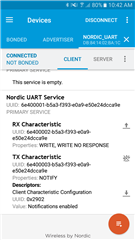Hello
I would like to send my sensor data to a mobile application using BLE SDK 15. Someone suggested me to go through the BLE NUS SERVICE example which was a good one. I understood a lot of things but now my sensor values are coming on analog pins and not on UART pins. How do i send those values? Would i have to create a whole new service for doing this or could i somehow modify the same example to work according to my needs. Thanks!



